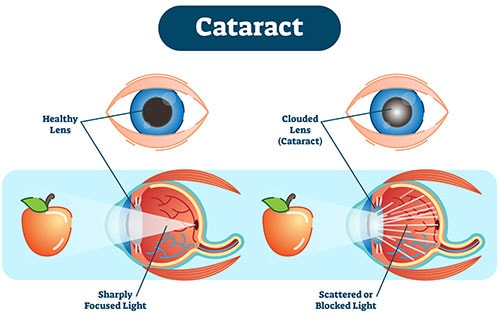
Dylan Thomas, the famous/notorious Welsh poet, strongly advocated vigorous defiance of aging: “Do not go gentle into that good night…. rage, rage against the dying of the light.”
Thomas’s “dying of the light” poetically evokes the gauzy veil that dims the vision of those suffering from the condition known as age-related cataracts.
What are cataracts?
As you age, the lens of your eye becomes less flexible, less transparent, and thicker. Age-related oxidation, as well as other medical conditions, causes tissues within the lens to break down and clump together. This results in cloudy areas appearing in the lens.
Cataracts are not sudden – the clouding of the patient’s vision will be gradual and slow. But, given enough time, cataracts will inevitably interfere with normal life. Essentials, such as reading and driving, will eventually become impaired and then impossible.
Cataracts are the leading cause of blindness and are among the most common serious eye diseases, ranking above both glaucoma and macular degeneration.
Half of all Americans will have a cataract before they reach the age of 80, and one-third of those will be younger than 60 when they incur their first cataract.
The only permanently effective treatment for cataracts is surgery, so it’s a good thing that the results of cataract surgery are both permanent and effective.
Can cataracts be prevented?
There is no single sure-fire method of cataract prevention. However, there are behaviors that can reduce the risk of cataracts and, when incurred, slow the development of cataracts. Those steps include:
Avoid exposure to sunlight
Ultraviolet light from the sun can contribute to the progression of cataracts, so UV protection is important. Wear sunglasses at every opportunity. You’ll look extremely cool, and your retinas will thank you.
Schedule regular eye exams
Early detection of any eye problem is important to eye health, of course. So let an eye doctor provide eye care that will minimize vision problems, including cataracts.
Limit your alcohol consumption
We’ll talk more about this in a moment.
If you smoke, don’t
This advice is pertinent to far more than eye problems. Tobacco usage creates, aggravates, and exacerbates a wide array of health problems, including vision loss from cataracts, not to mention cancer.
Maintain a healthy diet
This is really important for your overall health. Plan a menu replete with antioxidants, Omega-3 fatty acids, vitamin C, and leafy vegetables. This diet should prevent free radicals from causing oxidative stress, which can damage the proteins in the lens of the eye.
If you’re diabetic, closely monitor your blood sugar
Data suggest that those with diabetes are at greater risk of developing cataracts, so maintaining healthy blood sugar levels is vitally important.
Monitor and control your blood pressure
Several studies have indicated that hypertension itself, as well as many of the medications commonly prescribed to control hypertension, can cause the proteins in the lens of your eye to adhere to each other, thereby creating a cataract.
How drinking red wine is linked to a reduced risk of cataracts
We promised you more discussion on cataracts and alcohol use. This subject deserves special attention because of some recent findings from British studies.
The UK project known as Biobank has been studying almost 500,000 participants since 1989.
And when we say “studying,” we mean in-depth studies. Practically every conceivable aspect of these folks’ lives has been exposed, measured, studied, and tested. And the results have been broadcast to the world.
In late March of this year, the American Academy of Ophthalmology issued a report on the results of Biobank’s examination of the association between alcohol consumption and cataracts.
In the last 20 years, practically every article, treatise, or publication regarding cataracts has sternly advised the reader to avoid alcohol use.
Now the Biobank researchers are singing a different tune. And they may be singing that tune in the local bar.
Their results suggest that moderate alcohol intake is strongly associated with significantly reduced odds of developing cataracts severe enough to require surgery.
It appears undisputed that age-related cataracts result, at least in part, from oxidative stress to lens proteins. The contents of alcoholic beverages have been shown to increase antioxidant activity, and this is presumed to reduce the formation of cataracts.
What is resveratrol?
One of those alcoholic beverage components is resveratrol. It is a natural antioxidant, and its highest concentrations are found in red wine.
The antioxidant properties of resveratrol are strong (the Force is apparently with it). Resveratrol has been hypothesized to protect against several eye conditions, including age-related cataracts.
Pass the red wine. Hold everything else.
It’s noteworthy that the most significant cataract risk reductions reflected in the Biobank report are associated with red wine. The benefits fall off sharply when consuming white wine, champagne, beer, or whiskey.
Another possible explanation for the Biobank cataract reduction statistics arises from the skins of the grapes used to make red wine. It is a known fact that the skins of the grapes contain a very high concentration of the carotenoids lutein and zeaxanthin.
What are carotenoids?
Glad you asked. Carotenoids are an important group of natural pigments. They are found in a wide range of biological systems, including the biological systems of humans.
In addition to imparting color, carotenoids serve a vital role in human health; they are powerful antioxidants. The consumption of carotenoids has been associated with the prevention of some cancers, heart disease, and diseases of the human eye, including cataracts. And guess what? Red wine contains a high concentration of carotenoids.
What is moderate alcohol consumption?
We need to make it extremely clear that the reduced risk of cataracts is associated only with moderate use of alcohol. We’re not giving you license to binge!
The Biobank results graphed as an inverted “U”. In other words, the cataract-reducing properties of alcohol increase until the drinking passes beyond moderate. Drinking any amount above “moderate” actually significantly increases the risk of developing cataracts.
The Biobank report defined moderate drinking as one glass of red wine, three or four times a week. So getting buzzed is not a cure for cataracts. Sorry about that.
Why choose Assil Gaur Eye Institute for your eye care?
At AGEI, you will experience a state-of-the-art health care facility that brings together revolutionary technologies with experienced vision care professionals. Our goal is to help you achieve your personal best vision.
Please call 866-945-2745 or visit us here to make an appointment online. If you are experiencing any concerning symptoms, contact us immediately to determine the best time to schedule an exam.
At Assil Gaur Eye Institute we take our patients’ safety seriously. Our facility’s Covid-19 patient safety procedures exceed all CDC recommendations during this coronavirus pandemic. Masks are required in our institutes at all times.
We are conveniently located for patients throughout Southern California and the Los Angeles area at locations in or near Beverly Hills, Santa Monica, West Los Angeles, West Hollywood, Culver City, Hollywood, Venice, Marina del Rey, Malibu, Manhattan Beach, and Downtown Los Angeles.
- What’s New in Keratoconus Treatment? A 2024 Update - 04/16/2024
- Dr. Assil and His Team Correct the Side Effects of Laser Eye Surgery - 04/03/2024
- What is ocular herpes? - 09/22/2023














